Richard Alpert
Interviewed by Nick Kaye, San Francisco 5 February 2015
Follow the links for discussion of: Probe (1974) | South of the Slot | Ricochet (1978) | Particle Paintings (1979-84) | Particle Drawings (1979-84) | Array (1983) | Strategy for a Dance (1974) | Hand Generated Light (1975) | Self-Portrait (1978) | A Tight Thirteen Minutes (1978) | A Circular Route (1979) | Gyro (1981)
RA: As I reflect upon my work from the '70s, I find that by my attempt to 'explain' what I did and why I did it I am intellectualizing it. When I created these works the intellectual element was not my focus. Instead my work is connected to a physical reality that was grounded in the moment. By intellectualizing the past it takes away the power and beauty of my work. I am finding that 'explaining' creates a barrier to the experiential nature of my art. This is frustrating to me, but maybe inevitable.
Q: Was Probe (1974) your first performance?
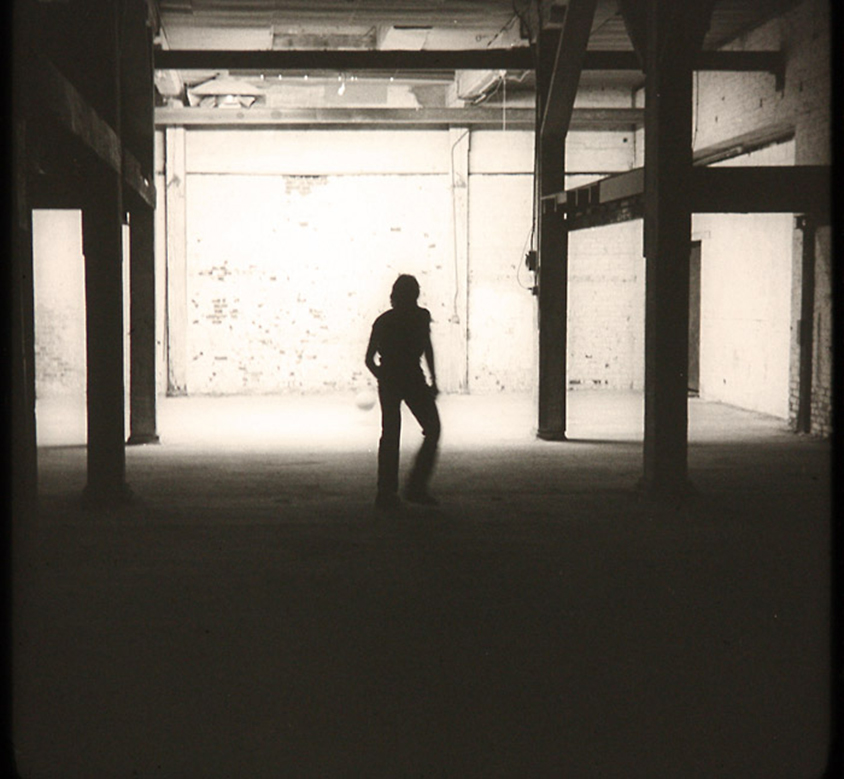
Richard Alpert, Probe (1974). Courtesy: Richard Alpert.
RA: Yes, it was my first performance after graduating from the San Francisco Art Institute.
Q: Why performance, as opposed to other modes of work?
RA: I think of performance art as sculpture presented in real time. It exists for a short period of time, but you can document it and describe it. Performance allowed me to work with sound, movement, energy, space and time in a context that made a direct connection with a viewer. I was very interested in sound and the energy that sound has. In general I'm interested in energy in many different forms, so I have applied that to different modes of creating things.
Q: So it was an energy transfer?
RA: Yes. I felt that I was energizing the space through intense physical activity and you know, Jacob Bronowski would say, man (who is the agent of this piece) is the carrier of Divine/Natural energy.
Q: How did the audience encounter it?
RA: They were standing outside the performance area in the darkened portion of the warehouse. There was no intermediary video or anything like that. They were exposed to the physical activity, the energy that I was exerting in that space and the sound that was emanating from the space.
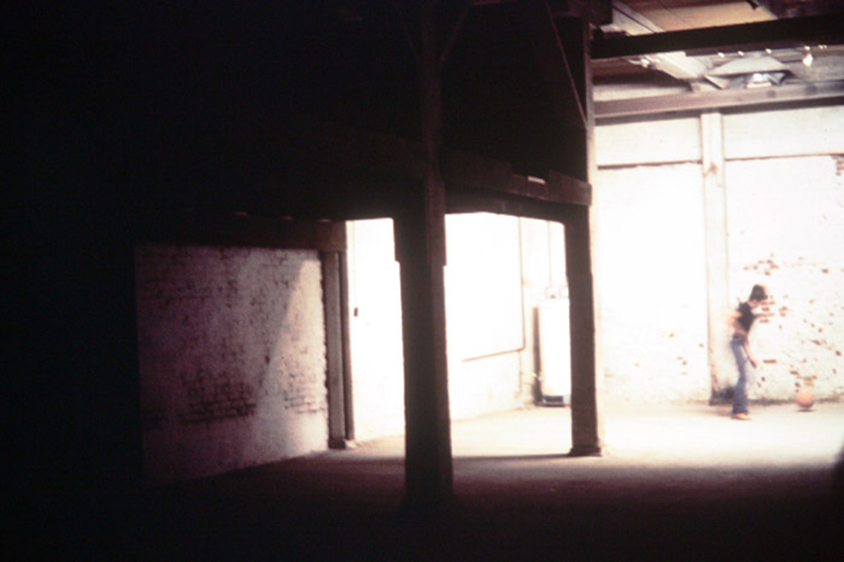
Richard Alpert, Probe (1974). Courtesy: Richard Alpert.
Q: How long was the performance?
RA: It was approximately 30 to 40 minutes.
Q: Was Probe different from the pieces that preceded it?
RA: This was my first opportunity to work with a large space. Previous work occupied more intimate spaces that didn't have a formal audience-performer boundary. Sound and physical energy were still a key aspect of that work.
Q: Were you thinking at the time about the connection with a scientific methodology?
RA: No, not really. Scientific methodology had little to do with it. Hypothesis, experiment and verification weren't as important as purely exploring the sound characteristics of the space. I was imagining the visual similarity between the performance and an energized particle of matter in a confined space. I was trying to extract from the space some evidence of its unique sound quality by using the reverberating sound of the ball striking the different surfaces. During the performance I was focused on controlling the flight of the ball. I wanted to fill the space with sound energy.
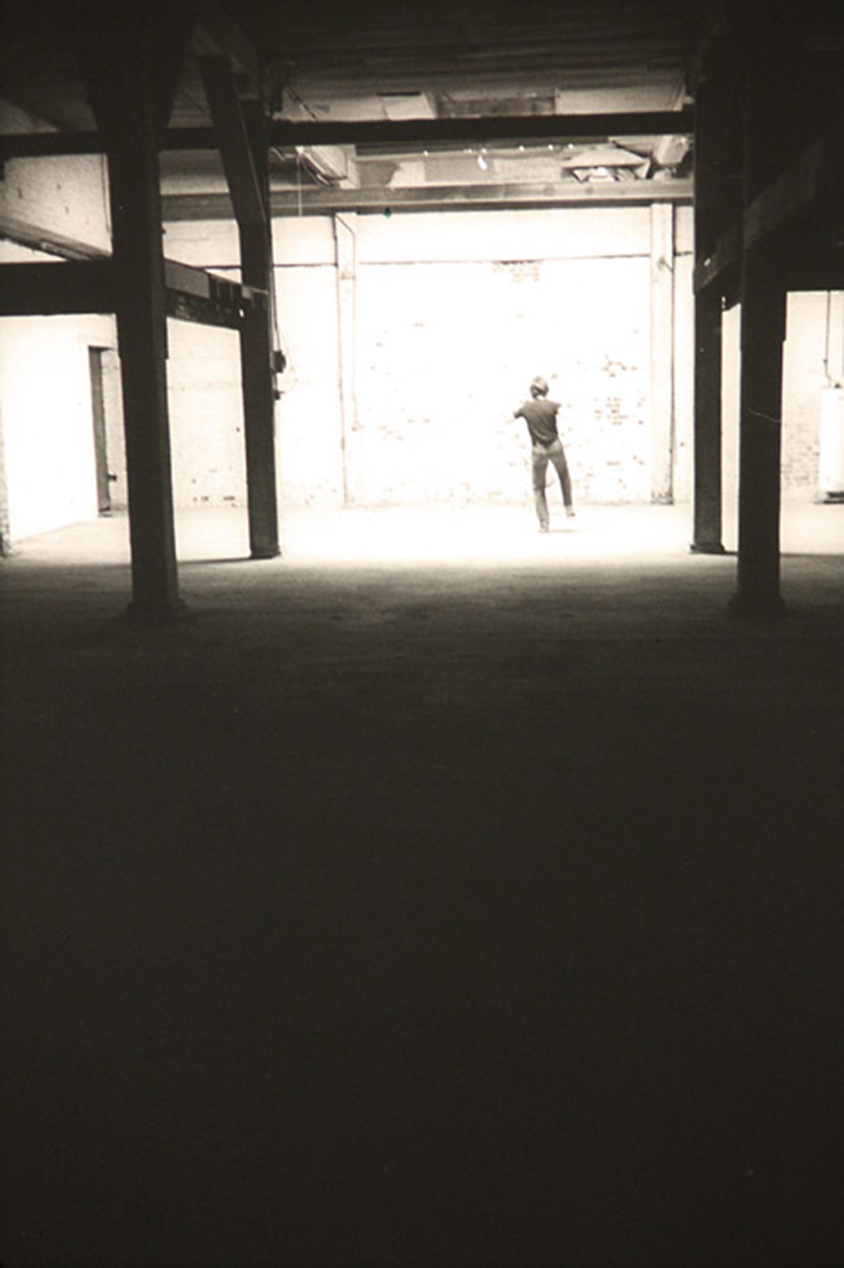
Richard Alpert, Probe (1974). Courtesy: Richard Alpert.
Q: And Probe was part of South of the Slot at 63 Bluxome Street? For which you were one of the organisers?
RA: Yes, I thought that it was a significant event and I wanted to preserve it. Part of my role was to help invite artists to participate, to photographically document some of the performances and to publish a catalogue.
Q: When you first began making performances, were there specific artists to whom you related your work?
RA: I admired Bruce Nauman's work very much for its simplicity and use of many different materials and language. I also had a connection to Tom Marioni's performance work. I liked that he took an action that generated sound and marked a surface at the same time. The sculptor Bill Geis (an instructor at the San Francisco Art Institute) introduced me to how word puns might create an interesting psychological and visual space. George Nama, who was teaching printmaking at the University of Pittsburgh, introduced me to the printmaking process and its importance as an approach to creating an object/image. Before Nauman it was Marcel Duchamp and his orientation to producing things and use of chance.
Q: Some of what you're saying makes me think of work by Terry Fox. The engagement with sound - but Fox's work also suggests a metaphysical aspect.
RA: I felt a definite affinity to the meditative quality of his performance work. Our backgrounds were very different and that led me to a different expression of performance art with those elements of materials and sound in a space.
Q: The style of your work is more overtly task-oriented.
RA: The structure that I designed for Probe was a template into which I could insert an energetic activity. Strenuous physical activity was an important factor in a lot of my work. The outpouring of physical energy into a tightly structured format allowed for a certain degree of control while also making room for chance results. How I got to the results was of equal importance as the results themselves.
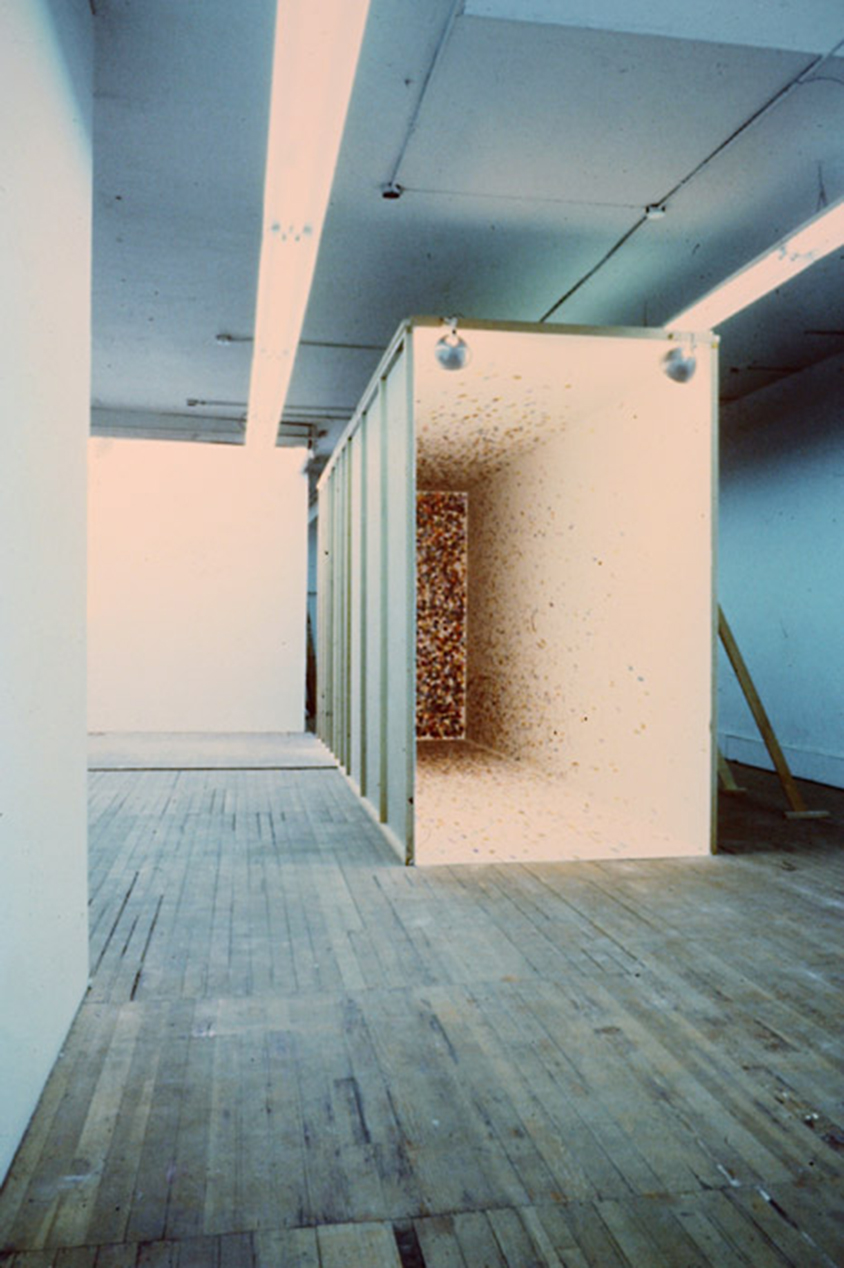
Richard Alpert, Ricochet (1978). Courtesy: Richard Alpert.
RA: The activity of propelling a ball inside a space with irregular surfaces led me to construct a large installation painting titled, Ricochet (1978). In Ricochet I used a part of print making method to mark the interior of a space that had uniformly smooth white surfaces. The activity of playing in that space by hitting a small rubber ball with an inked wooden paddle was a record of that process. It had visual similarities to the paths that protons make when they collide.
Q: So it's still very connected in its method to Probe - a process and exploration of marking a space. Do you think the performance or process is evident from what remains?
RA: It's subtle, but it's there. Ricochet and a series of drawings and paintings that followed titled, Particle Paintings and Particle Drawings (1979-1984) and Array (1983) if seen together provide enough clues to shed some light on how this work may have come about.
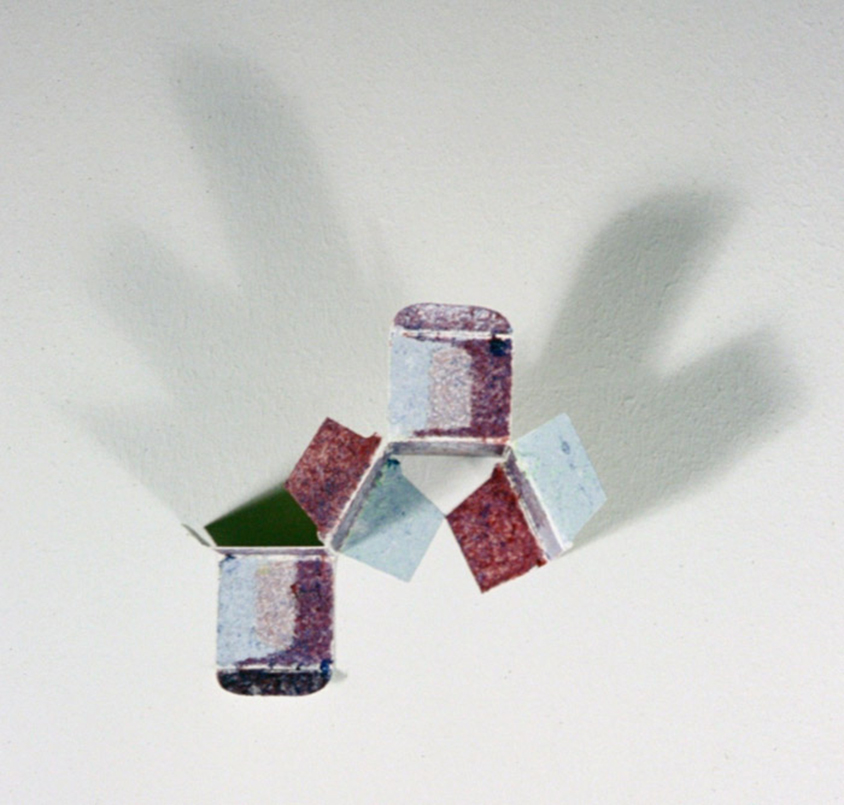 Richard Alpert, Small Unfolded Box No. 4 (1978). Courtesy: Richard Alpert.
Richard Alpert, Small Unfolded Box No. 4 (1978). Courtesy: Richard Alpert.
Q: How important was it to document the performances?
RA: It was important to me. I felt that there was a beauty in the visual images of my performance work and I wanted to capture and preserve that. Photographs and video were the way to go. There was something very important about having a good image or a good explanatory photograph.
Q: Did you repeat performances?
RA: Many of my performances had similar elements, but they all were designed specifically for the space and venue where they were presented.
Q: Were you aware of the Italian arte povera movement at that time? Artists like Gilberto Zorio, Giovanni Anselmo and Giuseppe Penone were exploring materials and potential or felt energy - the energy of the space was really important to this work, although it's usually articulated through the objects and installation rather than performance.
RA: Yes, I knew about the group, but wasn't familiar with specific works or the ideology behind them.
Q: It is focused on exposing forces like balance and gravity, but the metaphor is alchemical rather than strictly scientific. It is very interesting to hear you describe that methodological connection between your performance and objects, because your work seems to me to be carefully structured while having these things which are unpredictable operating within the unfolding of a very a rational structure.
RA: That's a good observation. I allow for - or invite into my work - randomness and chance. They leave the door open for surprise and discovery. Richard Dawkins, the evolutionary biologist, writes clearly about the concept of 'natural selection' and its relationship to chance events and evolution. My work reflects this understanding. Chance and randomness seem to be fundamental to how we came to be the way we are. Accident, surprise or arbitrary events are elements that I sometimes like to incorporate into my work. They also serve as variables that operate in the background to promote discovery.
Q: That sounds like an implicit link back to Duchamp, and his use of chance and quasi-scientific method in 3 Standard Stoppages (1913). It also makes me think of John Cage. Did Cage influence you? Much of Cage's work is rigorously structured and disciplined precisely in order to capture the unpredictable and the unexpected.
RA: His incorporation of chance into his work helped legitimize that concept for me.
Q: And another element of your performance is risk.
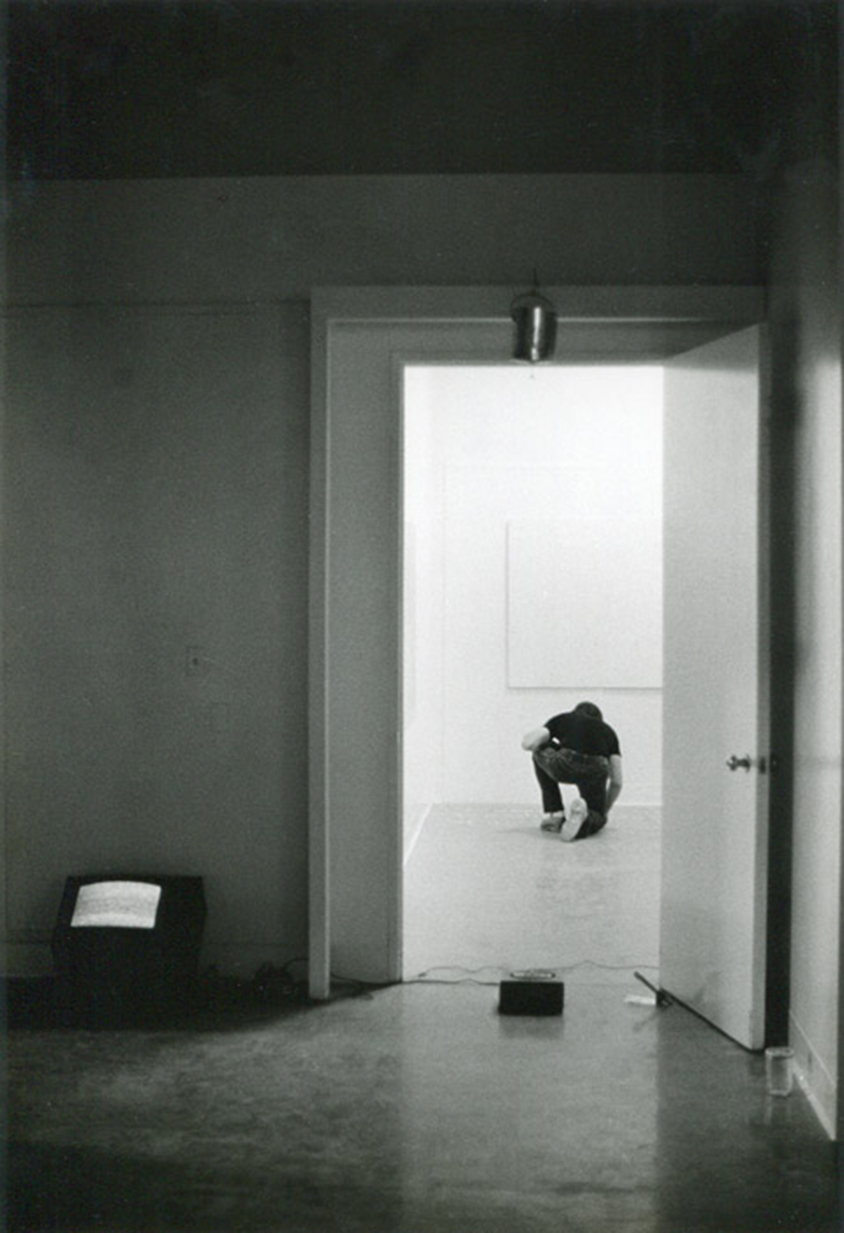
Richard Alpert, Strategy for a Dance (1974). Courtesy: Richard Alpert.
RA: There is something about exposing myself to physical risk in real-time that puts me in a very interesting psychological space. Strategy for a Dance (1974) was the first performance I did where I explored that. I initiated a dangerous situation for myself by propelling a lead weight tethered to the ceiling around a small room. I repeatedly hit the swinging weight with a sharp edged hammer until it disintegrated. I forced myself to protect myself. I made the object more dangerous and less dangerous at the same time. I like the idea of creating risk: to both create it and defend myself against it.
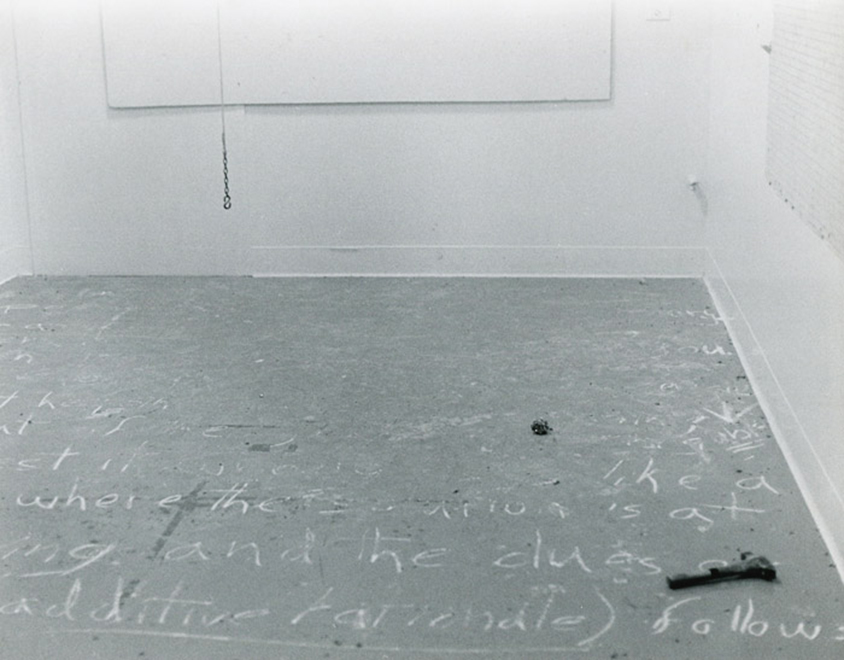
Richard Alpert, Strategy for a Dance (1974). Courtesy: Richard Alpert.
Q: So you were testing yourself through the performance?
RA: I put myself in a risky situation and I successfully forced myself to safety. The sense of danger reinforced another element of the piece which I constructed as a cautionary boundary between myself and the audience. I think that a number of my performances test my physical strength to perform a task.
Q: Where was your studio?
RA: My first studio was in the Mission District on 18th Street between Mission and Valencia. It was a garage and I lived above it.
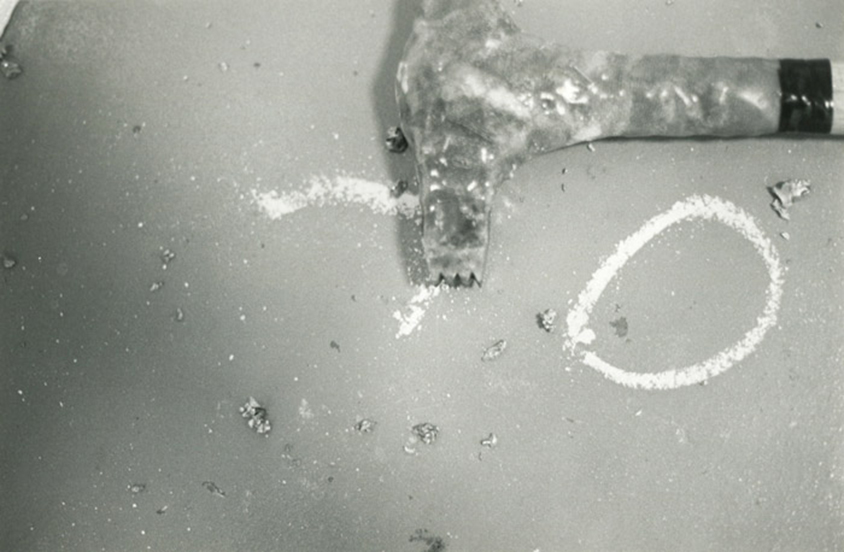
Richard Alpert, Strategy for a Dance (1974). Courtesy: Richard Alpert.
Q: Is that where you did Strategy for a Dance?
RA: No, that took place at the San Francisco Art Centre which was my second studio. I had the attic portion of the building. After that, I had a space upstairs at 63 Bluxome Street and a studio in P.S. 122 on the lower eastside of Manhattan, where ironically my father went to school. The last studio I had was in the Bayview Hunter's Point district of San Francisco near Candlestick Park. That building was destroyed by a massive explosion and fire in 1986.
Q: You lost a lot of work.
RA: Yes, I did. However, I was able to post photos I'd taken of some of the pieces that were destroyed on my website. I was in my studio when it blew up. I was very fortunate to get out of the building alive, other people were not as lucky.
Q: After Probe what was the next important step, in terms of the pieces that you made?
RA: I started working with a hand crank generator that I found in an Army/Navy Surplus store on Market Street in San Francisco. It resulted in a performance titled, Hand Generated Light (1975) at the Museum of Conceptual Art.
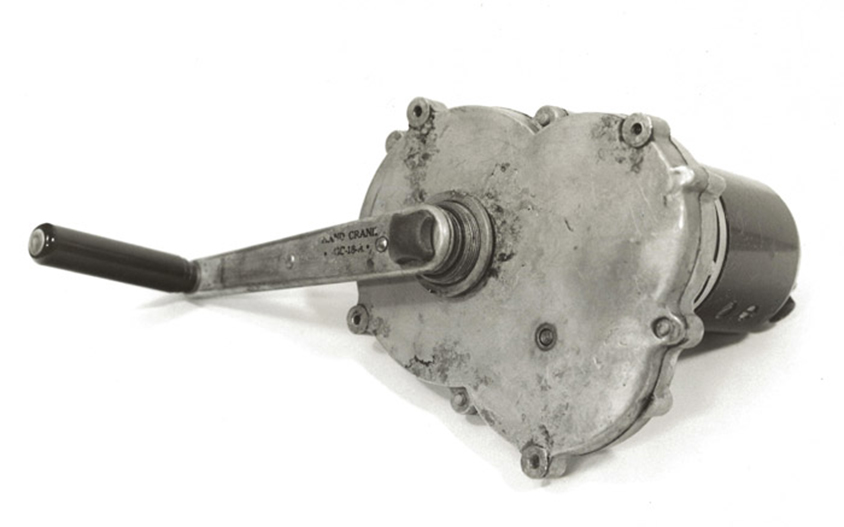
Richard Alpert, Hand Generated Light (1975). Courtesy: Richard Alpert.
Q: And that was a three-hour performance?
RA: Yes. The name of that work was Hand Generated Light (1975). It was a symbol for the light of life within us. The challenge was: could I keep that activity up for that period of time? Again, it was a very physical activity and there was sound involved. It was somewhat monotonous, but it had variations in the volume of the sounds. Hand Generated Light was reaffirming of life's energy, the energy we have to light our world, to stay alive; that spark which takes us out of the inanimate to the animate.
Q: How did the audience encounter that, did they come and go?
RA: I had no direct contact with the audience. I was behind a locked storage room door, in a storage space, for the duration of the show. I secured a small light bulb on the outside of the door. The door stayed closed while I kept the bulb lit by generating electricity.
Q: Which location was it?
RA: It was at MOCA on 3rd between Mission and Market. I was above Breen's bar, where Tom Marioni had a group every Wednesday. You could come in and have a beer.
Q: Did you used to go to the group?
RA: Yes, I did.
Q: How important was Breen's?
RA: It was a focal point of non-mainstream art in San Francisco. You could count on it happening regularly. Artists from outside San Francisco seemed to make it a scheduled stop as they passed through. It kept me in touch with other artists. There was a cast of characters, sort of regular characters that came through and we'd talk about the art world, we'd talk about individual pieces, but it was mostly about events that were happening.
Q: When did you start using video?
RA: Strategy for a Dance was the first time I used video in a public performance. The San Francisco Art Institute had a Sony ½ inch reel-to-reel tape video recorder that was shared by the students. That was my first chance to work with the medium.
Q: Did you then become interested in video as a medium in itself or was it always a kind of adjunct?
RA: I was primarily interested in the real-time quality of video. Also its ability to focus in on some aspect of a performance. I found those attributes valuable in my work and occasionally I used video for its ease of recording. All these attributes came together in Self-portrait (1978). That was in the show, A Tight Thirteen Minutes (1978) presented on a community television channel in San Francisco. Tom Marioni and I did that piece. There was a phone booth right across from his office in MOCA upstairs. Tom was in the office and I had asked him on a signal to call the phone booth and just ask, 'Have you found anything interesting lately?' So as I was walking by the phone booth, the phone booth was ringing and I went in and picked up the phone. My head was full of ideas. I just started talking and unloading them. There was no dialogue, just my monologue. Video helped focus on the telling of this story in real-time.
Q: It seems to me that with many of your works that one can't quite locate the work in the sound and one can't quite locate the work in the material: it produces an in-between space.
RA: When I was studying at the San Francisco Art Institute, Bill Geis, a sculptor/instructor, talked about incorporating an element of 'in between-ness', like a pun into a painting or sculpture, in order to try to give the work another dimension. I was very struck by that idea. Trying to create a cognitive state of mind like that in a viewer could possibly create a very different level of consciousness. I think that when the mind tries to process information perceived as 'valid' either of two ways the result is fertile ground for the imagination.
Q: That also relates to Bruce Nauman of course, who uses language in a very plastic way, and also uses puns. And of course in his sound pieces, the way the sounds are formed is explicitly sculptural and they seem to depart from the meaning of the words that you hear. The 'in between space' is a very powerful idea. Then you did A Circular Route (1979). Could you tell me about your thinking for that piece and where it took place?
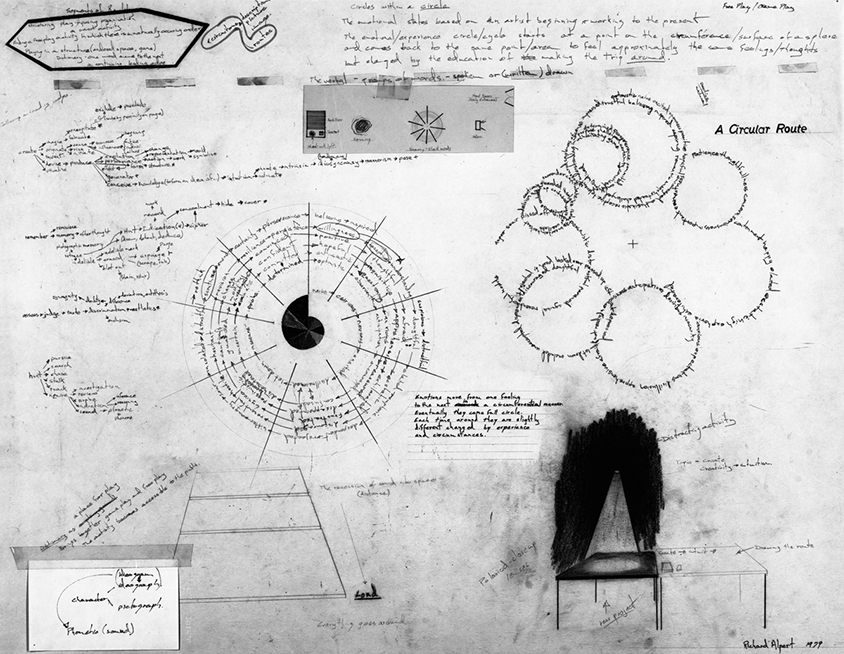 Richard Alpert, A Circular Route (1979). Drawing notes. Courtesy: Richard Alpert.
Richard Alpert, A Circular Route (1979). Drawing notes. Courtesy: Richard Alpert.
RA: I wanted to create a work that embraced not only the natural and spiritual aspects of perception, but also the idea of continual change as the only real constant in life. I illustrated this by using the temporal nature of the chalk, the video image, the spinning form of a human dancer as well as the shadow of the spinning bicycle wheel. This was a onetime installation piece that I constructed at The Farm, an exhibition space in San Francisco. I presented four different ways that I experience the material and nonmaterial world. Visual imagery, sound, physical movement and thought were examples that I chose to work with. The piece consisted of: a spiral of written words in chalk describing my emotional states of mind, a video of sound being generated by someone 'playing' a spinning bicycle wheel, a spinning dancer and the shadow of the spinning bicycle wheel. I used the speed it took for the wheel to spin to determine the length of the piece. The sound from the spokes filled the entire building and created a spiritual 'other worldliness' quality in the space. It sounded like a carillon. At the same time, I wanted that sound to reinforce the impermanent nature of the material components of the installation. The discarded bicycle wheel was a 'found object' that I mounted horizontally on a resonating box. It made a great spinning instrument to play with. That bicycle wheel instrument is on exhibit at the SF Exploratorium and you can play with it.
Q: It's a beautiful piece.
RA: Thank you. Playing with the bicycle wheel connected me historically to Marcel Duchamp's Bicycle Wheel (1913). For me it was a natural and fun way to explore the sound potential of that object.
Q: In Gyro (1981) you recount flying an aircraft and the risks involved in that.
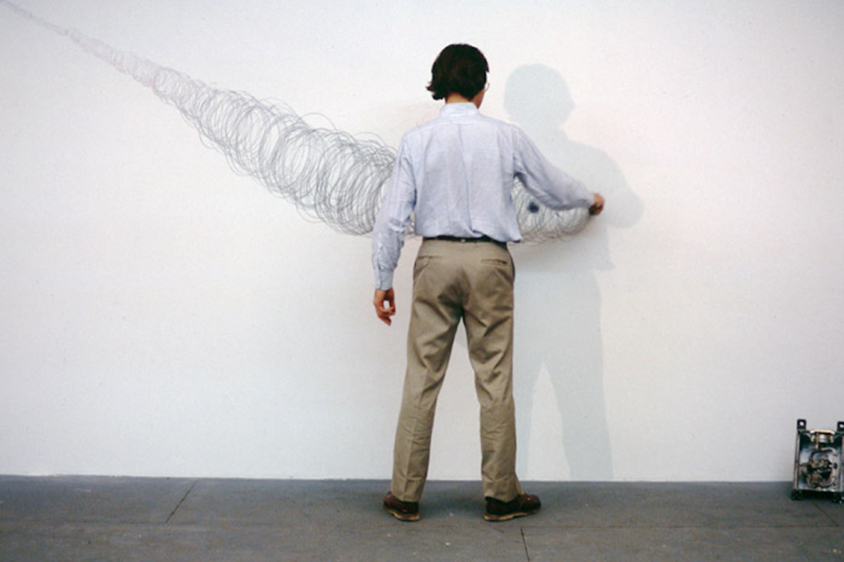
Richard Alpert, Gyro (1981). Courtesy: Richard Alpert.
RA: In Gyro I presented that risk in two ways. The first linguistically: the audience listened to my taped description of a near fatal incident that I experienced while flying. As they listened, I preformed actions that represented various crucial elements of flying an aircraft, such as the spinning gyroscope (stability) and kinaesthetic intelligence (control and balance). I simulated a vortex by spinning a one-sided propeller on the wall. These are some of the high-risk actions and concepts associated with the act of flying and landing an aircraft.
Q: It's interesting to me also, because it's a telling of a story and - while your performances are very present tense - this is moving between the present tense and the past, in recollection. The story is quite detailed - it takes time to tell.
RA: Being immersed in an activity that involves a high degree of life threatening risk gives me a heightened sense of feeling awake.
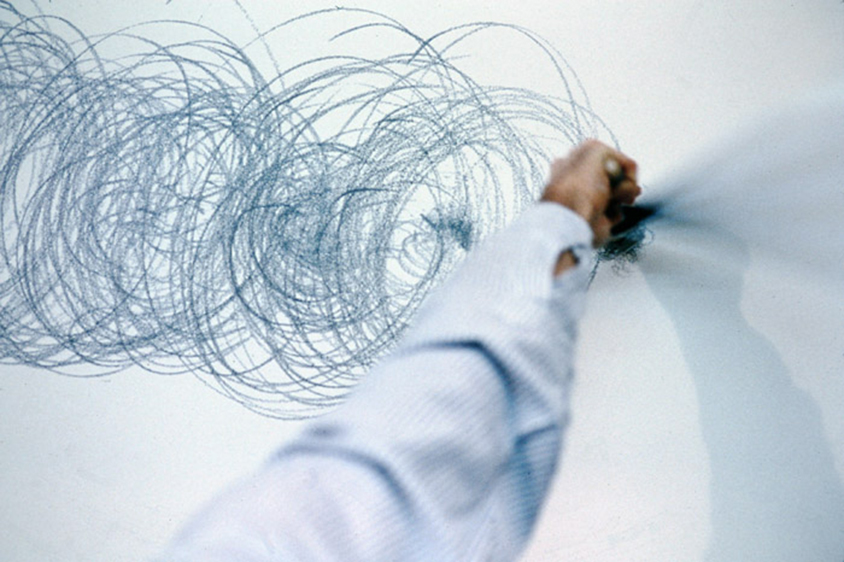
Richard Alpert, Gyro (1981). Courtesy: Richard Alpert.
Q: Why did you step out of performance?
RA: There seemed to be fewer opportunities available and my interests shifted. I stepped out of the arena of performance art and into the world of object sculpture and painting. I needed to produce income as well. However, I had a dilemma: while I liked the money, I didn't like that the work I sold was being used as decoration. That was not the reason for my art. I made a deliberate exit from the art world culture because it became too small and insulated a context. I continued my work, but I stopped seeking out venues to present it. I turned my performance work to a new arena: competitive downhill snow ski racing.
Q: When did you do that?
RA: 1999 - 2009. However, in 2009 I had a serious, near fatal accident that ended that activity.
Q: What form is it in? Could you talk about how you did performance art in that context?
RA: The snow ski slope on which the slalom race course was laid out was my 'canvas'. I envisioned the line that I carved traversing the slope as I skied around the gates as a metaphor for the energy centres, or Chakras, in the human body. Racing made me experience a spiritual state of focused attention while simultaneously having both feet anchored in the material world. Another interesting thing about this activity happens by creating something in the horizontal plane and presenting it in the vertical plane. This reminded me of the work of Jackson Pollock and the ancient Greek philosopher and mathematician, Pythagoras.
Q: That's great, that's really interesting.
RA: That was a risky situation that didn't turn out so well.
[Laughter]
Q: I mean you're here now.
RA: Yes, I'm lucky to be here now. I made it through the fire and explosion at my studio, the flying incident, the ski accident and several other near brushes with death in my life. Each time it seems like the coin toss fell in my favour.
Q: That's great, that's a wonderful sort of way of ending the interview.